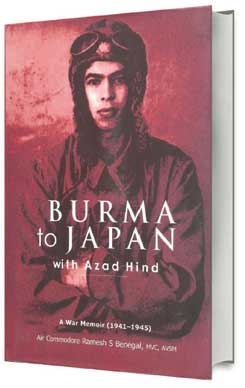 Late Air Commodore Ramesh S Benegal MVC AVSM’s book is a treasure trove of his accounts from Azad Hind Fauj as well as the Indian Air Force
Late Air Commodore Ramesh S Benegal MVC AVSM’s book is a treasure trove of his accounts from Azad Hind Fauj as well as the Indian Air Force
This ia an unimaginable narrative of ordeals and tribulations endured by Late Air Commodore Ramesh S Benegal MVC AVSM. A patriot to the core, he kept it all close to his heart and penned it down in hand, only after he had laid down his office. Some of us who were privy to snatches of this account are immensely grateful to Meera Benegal, his devoted wife of several decades, for endeavouring to publish Burma to Japan with Azad Hind: A War Memoir (1941-45) as a war memoir; six years after the military hero passed away. Benegal was born in 1926 in Rangoon in Burma (now Yangon of Myanmar) to migrant Indian parents and his recall commences when he was 15 years of age and witnessed the spurring of the exodus after the Japanese Air Force pulverised the Royal Air Force and eventually went on to capture Rangoon in March, 1942. Benegal’s family, however, stayed on despite the warnings.
The fascinating story unravels unprecedented adventure during which he survived a 23-day Death Railway journey through the jungles of Burma and Thailand; escaped unscathed from a torpedoed ship in the South China Sea; withstood the blaze of dayand- night bombings in the American attacks over Japan.
He endured a 28-day incarceration on a starvation diet in the British-manned infamous Stanley Prison in Hong Kong, with seven days in solitary confinement and his personal belongings being stolen by the British prison guards; an arduous voyage as prisoners on the HMS Glenhearn to Manila, Singapore and Madras, to be imprisoned again — now in his own country.
The process of resurrection of his youthful dream commenced only after India gained independence in 1947, foundations of which were laid after his induction in Netaji Subhash Chandra Bose-led Azad Hind Army (INA) and his flying training as a Tokyo Cadet under the Imperial Japanese Air Force. The picture on the cover of the book, designed by journalist Shiv Aroor, adroitly portrays that persona of a determined Benegal.
His nationalism and aspirations of an independent India will make a lasting impression on the readers when he verbatim recalls Netaji’s words addressed to him and his small motley group: “You have been chosen to go to Japan for military training as that country has better facilities then we can afford at this time. I would like you to remember that you are going there as foreign cadets, as members of a free nation — Azad Hind. At no time do you act servile or feel inferior to any one there.” Ramesh remembered these words and revered Netaji.
This sentiment has percolated into the psyche of his nephew, the eminent Indian filmmaker Shyam Benegal, who went on to make a film Netaji Subhash Chandra Bose: The Forgotten Hero. The director idolises his uncle. But Benegal’s association with the Indian National Army caused him to lose three priceless years of his adulthood. That is because his application to join the Indian Air Force of independent India in 1947 was summarily rejected by the British officers. It was only in 1950, when more free-thinking officialdom of the service recognised his value, and made sure he joined the service.
It is now time to bring home the Legend of Bene, as he was affectionately called, in the afterword to the book by retired Air Marshal GCS Rajwar. Like Rajwar, I was also one of the Navigators in No 106 Strategic Reconnaissance Squadron of the IAF during 1968-72, commanded by Wing Commander Benegal. Rajwar’s lifelike account limits itself to the period of only the 14-day war, where he narrates the historical missions to Khunjareb Pass and Gwadar Bay and touches on the coverage of Tezgaon and Kurmitola airfields. But the larger truth is that under Bene’s tutelage, the Canberra PR7s of the squadron used to rule the skies of the area surrounding the subcontinent, with verve, craft and impunity, on photo missions and reach where its range took it to. It was a quiet and discreet work.
I recall compiling a diary of our activities which in no time was declared a top secret document and taken away. This is, perhaps, one of the reasons why his phenomenal contribution was initially acknowledged with only a meritorious service AVSM in January 1971, although, normally awarded to the ranks of Air Commodore and above. The real recognition for gallantry, during supra high-risk assignments came with his MVC in December, 1971.
Bene’s professionalism cannot be gauged by a standard yardstick because he had to decide beyond the normal. His professional stature was such that when this Wing Commander spoke, the chief and the commanders listened. Because they knew that only a person of his calibre can take an unarmed plane across the borders and bring the results back with certainty.
Wisdom and knowledge had made him fearless. His forceful advice in favour of the tactical photo coverage of the approaches to Dhaka, as against a time-consuming survey of the region sought by the military leaders, was acceded to. Bene, with his humility and in the interest of team play had done away with the “aloof existence” practiced by his predecessors. The regret is that he could not grow in the IAF as the “age to rank” policy came in his way. He was older; already 24 years old when he received his commission.
